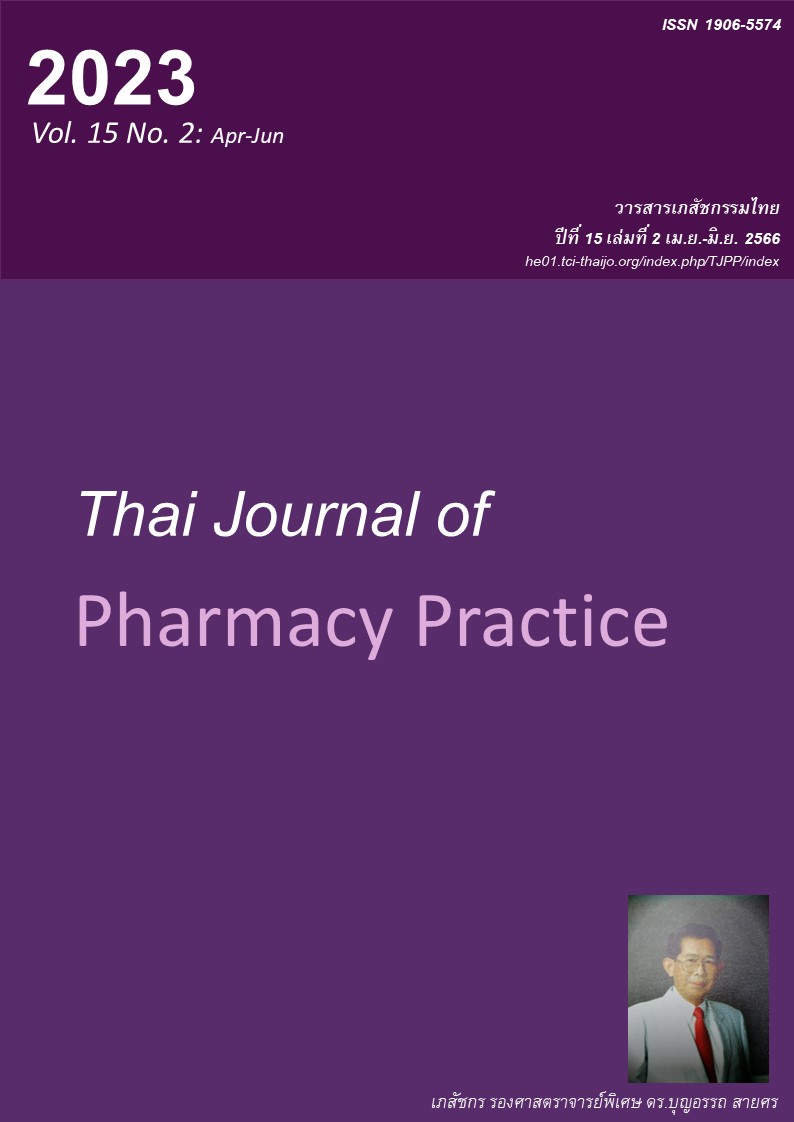การเปรียบเทียบผลการควบคุมค่าการแข็งตัวของเลือดของผู้ป่วย ในคลินิกวาร์ฟารินกับคลินิกทั่วไปของโรงพยาบาลศรีสะเกษ
Main Article Content
บทคัดย่อ
วัตถุประสงค์: เพื่อเปรียบเทียบผลการควบคุมค่าการแข็งตัวของเลือด และการเกิดภาวะแทรกซ้อนของผู้ป่วยในคลินิกวาร์ฟารินและคลินิกทั่วไปในโรงพยาบาลศรีสะเกษ วิธีการ: การวิจัยนี้เป็นการศึกษาแบบไปข้างหน้าใน ตัวอย่างที่เป็นผู้ป่วยนอกที่ได้รับการรักษาด้วยยาวาร์ฟารินที่คลินิกพิเศษโรคหัวใจ กลุ่มงานอายุรกรรมจำนวน 143 ราย และที่คลินิกทั่วไปจำนวน 143 ราย ซึ่งมารับบริการในระหว่างวันที่ 1 สิงหาคม พ.ศ. 2561 ถึง 31 ตุลาคม พ.ศ. 2561 ตัวอย่างถูกเลือกโดยวิธีสุ่มตัวอย่างแบบมีระบบในอัตราส่วน 1:1 ตัวอย่างทั้งหมดได้รับการติดตามอย่างต่อเนื่องจนครบ 3 ครั้ง ผู้วิจัยได้ให้การบริบาลทางเภสัชกรรมแก่ผู้ป่วยและเก็บข้อมูลทางคลินิก รวมถึงสอบถามปัญหาที่เกิดจากยาของผู้ป่วย ผลการวิจัย: ระยะเวลาที่ค่า INR อยู่ในช่วงการรักษาของตัวอย่างทั้งสองกลุ่มไม่แตกต่างกันอย่างมีนัยสำคัญทางสถิติ (ร้อยละ 54.85 และ 50.20 ตามลำดับ; P=0.43) ถึงแม้ว่าตัวอย่างในคลินิกวาร์ฟารินจะมีสัดส่วนดังกล่าวที่สูงกว่าผู้ป่วยในคลินิกทั่วไป เภสัชกรในคลินิกวาร์ฟารินตรวจพบอาการไม่พึงประสงค์จากการใช้ยาวาร์ฟาริน 41 เหตุการณ์หรือ 0.69 คน-ปี ส่วนในคลินิกทั่วไปพบเพียง 7 เหตุการณ์ (0.11 คน-ปี) ผู้ป่วยสามารถใช้ยาได้อย่างถูกต้องมากขึ้น แต่ยังคงพบอุบัติการณ์การเกิดอาการไม่พึงประสงค์จากยา 1 ราย คือ เลือดออกไม่รุนแรง แต่ไม่พบอาการไม่พึงประสงค์ที่รุนแรง สรุป: การมีเภสัชกรประจำคลินิกวาร์ฟาริน ทำให้สามารถตรวจพบปัญหาที่เกิดจากการใช้ยาวาร์ฟารินมากขึ้น ผลการศึกษานี้อาจนำไปสู่การขยายเครือข่ายการบริบาลเภสัชกรรมผู้ป่วยนอก แผนกอายุรกรรมระบบประสาท ในโรงพยาบาลศรีสะเกษ
Article Details

อนุญาตภายใต้เงื่อนไข Creative Commons Attribution-NonCommercial-NoDerivatives 4.0 International License.
ผลการวิจัยและความคิดเห็นที่ปรากฏในบทความถือเป็นความคิดเห็นและอยู่ในความรับผิดชอบของผู้นิพนธ์ มิใช่ความเห็นหรือความรับผิดชอบของกองบรรณาธิการ หรือคณะเภสัชศาสตร์ มหาวิทยาลัยสงขลานครินทร์ ทั้งนี้ไม่รวมความผิดพลาดอันเกิดจากการพิมพ์ บทความที่ได้รับการเผยแพร่โดยวารสารเภสัชกรรมไทยถือเป็นสิทธิ์ของวารสารฯ
เอกสารอ้างอิง
Kearon C, Kahn SR, Agnelli G, Goldhaber S, Raskob GE, Comerota AJ. Antithrombotic therapy for venous thromboembolic disease: American College of Chest Physicians Evidence-Based Clinical Practice Guidelines (8th Edition). Chest. 2008; 133(6 Suppl): 454S-545S.
Singer DE, Albers GW, Dalen JE, Fang MC, Go AS, Halperin JL, etal. Antithrombotic therapy inatrial fibrillation: American College of Chest Physicians Evidence-Based Clinical Practice Guidelines (8th Edition). Chest. 2008; 133(6 Suppl): 546S-92S.
Salem DN, O'Gara PT, Madias C, Pauker SG. Valvular and structural heart disease: American College of Chest Physicians Evidence-Based Clinical Practice Guidelines (8th Edition). Chest. 2008; 133(6 Suppl): 593S-629S.
Albers GW, Amarenco P, Easton JD, Sacco RL, Teal P. Antithrombotic and thrombolytic therapy for ischemic stroke: American College of Chest Physicians Evidence-Based Clinical Practice Guidelines (8th Edition). Chest. 2008; 133(6 Suppl): 630S-69S.
Ansell J, Hirsh J, Hylek E, Jacobson A, Crowther M, Palareti G. Pharmacology and management of thevitamin K antagonists: American College of Chest Physicians Evidence-Based Clinical Practice Guidelines (8th Edition). Chest. 2008;133(6 Suppl): 160S-98S.
Holbrook AM, Pereira JA, Labiris R, McDonald H, Douketis JD, Crowther M, etal. Systematic overview of warfarin and itsdrug and foodinteractions. ArchIntern Med. 2005;165:1095-106.
Fihn SD, Callahan CM, Martin DC, McDonell MB, Henikoff JG, White RH. The risk for and severity of bleeding complications in elderly patients treated with warfarin. The National Consortium of Anticoagulation Clinics. Ann Intern Med. 1996; 124: 970-9.
Palareti G, Leali N, Coccheri S, Poggi M, Manotti C, D'Angelo A, etal. Bleeding complications of oral anticoagulant treatment: aninception-cohort, prospective collaborative study (ISCOAT). Italian Study on Complications of Oral Anticoagulant Therapy. Lancet. 1996; 348(9025): 423-8.
Hylek EM, Singer DE. Risk factors for intracranial hemorrhage in outpatients taking warfarin. Ann Intern Med 1994; 120: 897-902.
Hart RG, Boop BS, Anderson DC. Oral anticoagu lants and intracranial hemorrhage. Facts and hypo- theses. Stroke. 1995; 26: 1471-7.
Risk factors for stroke and efficacy of antithrombotic therapy in atrialfibrillation. Analysis of pooled data from five randomized controlled trials. Arch Intern Med. 1994; 154: 1449-57.
Bleeding during antithrombotic therapy in patients with atrialfibrillation. The Stroke Prevention in Atrial Fibrillation Investigators. Arch Intern Med. 1996; 156: 409-16.
Boonbaichaiyapruck S, Panchavinnin P, Suthichai yakul T, Benjanuwatra T, Sukananandachai B, Mahawanakul W, etal. Behavior of prothrombintime (INR) in response to warfarin therapyin a Thai population. Thai Heart Journal 2006; 19: 85-9.
Lertsinudom S CP, Chaiyaokum A. Drug use review of warfarin in medicine ward, Srinagarindhospital. Srinagarind Medical Journal 2010; 25: 6-13.
Garabedian-Ruffalo SM, Gray DR, Sax MJ, Ruffalo RL. Retrospective evaluation of a pharmacist-managed warfarin anticoagulation clinic. Am J HospPharm. 1985; 42: 304-8.
Chiquette E, Amato MG, Bussey HI. Comparison of an anticoagulation clinic with usual medicalcare: anticoagulation control, patient outcomes, and healthcare costs. Arch Intern Med. 1998; 158: 1641-7.
Wilson SJ, Wells PS, Kovacs MJ, Lewis GM, Martin J, Burton E, etal. Comparing the quality of oral anticoagulant management by anticoagulation clinics and by family physicians: a randomized controlled trial. CMAJ 2003; 169: 293-8.
Witt DM, Sadler MA, Shanahan RL, Mazzoli G, Tillman DJ. Effect of a centralized clinical pharmacy anticoagulation service on the outcomes of anticoagulation therapy. Chest 2005; 127: 1515-22.
Cios DA, Baker WL, Sander SD, Phung OJ, Coleman CI. Evaluating the impact of study-level factors on warfarin controlin U.S.-based primary studies: a meta-analysis. Am J Health SystPharm. 2009; 66: 916-25.
Chamberlain MA, Sageser NA, Ruiz D. Comparison of anticoagulation clinic patient outcomes with outcomes from traditional care in a family medicine clinic. J Am Board Fam Pract. 2001;14: 16-21.
Ketchumpon K, Eaokareok S, Pimanpeang W. Cardi ology.Clinical outcomes of pharmacist-managed care for warfarin clinic in Sisaket hospital [online]. 2014 [cited Nov 13, 2019]. Available from: www.cr hospital.org/CNF2014/?P=regist_chk
Rosendaal FR, Cannegieter SC, Vander Meer FJ, Briet E. A method to determine the optimal intensity of oral anticoagulant therapy. Thromb Haemost 1993; 69: 236-9.
Heart Association of Thailand. Guideline of oral anti- coagulants treatment 2011. Bangkok: National Health Security Office; 2011.
Gallus AS, Baker RI, Chong BH, Ockelford PA, Street AM. Consensus guidelines for warfarin therapy. Recommendations from the Austral asian Society of Thrombosis and Haemostasis. Med J Aust 2000; 172: 600-5.
Fuster V, Ryden LE, Cannom DS, Crijns HJ, Curtis AB, Ellenbogen KA, etal. ACC/AHA/ESC 2006 guidelines for the management of patients with atrialfibrillation—executive summary: a report of the American College of Cardiology/American Heart Association Task Force on Practice Guidelines and the European Society of Cardiology Committee for Practice Guidelines (Writing Committee to Revise the 2001 Guidelines for the Management of Patients with Atria lFibrillation). J Am Coll Cardiol. 2006; 48: 854-906.
Bonow RO, Carabello BA, Chatterjee K, deLeon AC, Jr., Faxon DP, Freed MD, et al. 2008 Focused update in corporated into the ACC/AHA 2006 guidelines for the management of patients with valvular heart disease: a report of the American College of Cardiology/American Heart Association TaskForce on Practice Guidelines (Writing Committee to Revise the 1998 Guidelines for the Management of Patients With Valvular Heart Disease): endorsed by the Society of Cardiovascular Anesthesiologists, Society for Cardiovascular Angiography and Interventions, and Society of ThoracicSurgeons. Circulation. 2008; 118: e523-661.
Panichsombat T. Development of pharmaceutical care for warfarin patients in Bantak hospital [online]. 2018 [cited Mar 12, 2021]. Available from: bantakhos pital.go.th/file/20827483120170118_232355.pdf.
Prasopakarakit A. Development of warfarin clinic for patients in Ratchapipat hospital online]. 2018 [cited Mar 12, 2021]. Available from: 203.155.220.238/csc/ attachments/article/196/pharma630301.pdf


